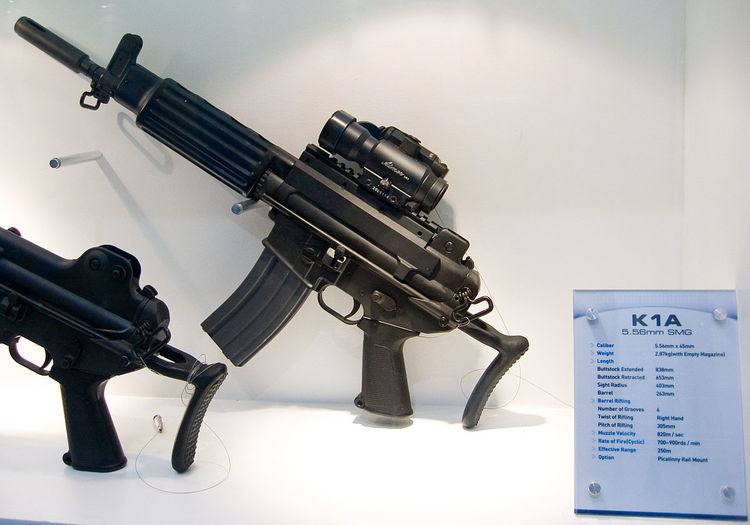In service 1981-present | Place of origin Republic of Korea Used by See Users | |
 | ||
Wars Persian Gulf WarWar in AfghanistanIraq War Designer Agency for Defense DevelopmentDaewoo Precision Industries | ||
The Daewoo Precision Industries K1/K1A is a South Korean service rifle, the first modern firearm developed by Agency for Defense Development (ADD) and manufactured by Daewoo Precision Industries, and entered service in the Republic of Korea Armed Forces in 1981. Although the K1 uses .223 Remington, it is classified as a submachine gun by the South Korean military and the current manufacturer S&T Motiv, because the K1 was intended to replace the M3 submachine gun. Outside of South Korea the K1 is sometimes described as an assault rifle or as a carbine.
Contents
Development
In 1976, the ROKA Special Warfare Command requested a new weapon to replace the old M3 submachine gun. In the following year, ADD launched a project derived from XB rifle, which started in 1972 to replace licensed M16A1s with indigenous weapons. Under the demands of the ROKASWC, the new submachine gun must acquire greater firepower, light weight, cost effectiveness, and easy access to spare parts. The first prototypes were made in 1980, and entered service in 1981 after series of field test. However, due to the design of its flash suppressor, the K1 exhibited serious problems in service with the ROK armed forces. The original version had excessive recoil, noise, flash, and weak stock due to increase in firepower. These problems caused difficulty in aiming especially during night operation.
These shortcomings were later fixed by the development and adoption of a new flash suppressor, which has three holes in the top right quadrant to limit muzzle flip under rapid fire and reduces flash to one-third of that of the early K1. This new version of K1 is known as the K1A and its production began in 1982. All K1 sumbmachine gun in service were subsequently modified to the K1A standard.
The K1A is often mated with the PVS-4K Rail integration System.
Differences
Most of the time, K1 submachine gun is regarded as a shortened or carbine version of Daewoo Precision Industries K2 assault rifle. However, although two guns share development history, two guns are very different from each other for the following reasons:
The carbine version of K2 named K2C was developed and shown to the public in 2012 by S&T Motiv.
Variants
Users
Future replacement
S&T Motiv K2C, upgraded and carbine version of K2 rifle, is under test by the Republic of Korea Army Special Warfare Command for the replacement. The Republic of Korea Armed Forces is planning to field K2C starting in 2015.
